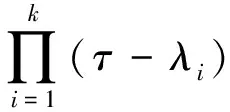The Note on Diagonalizable Linear Operators
2010-11-22HUANGYunbao
HUANG Yun-bao
(College of Science, Hangzhou Normal University, Hangzhou 310036, China)

Theorem1([1], Theorem 8.11) A linear operatorτ∈() on a finite-dimensional vector spaceis diagonalizable if and only if its minimal polynomialmτ(x) is the product of distinct linear factors.
In what follows, we provide a new proof of Theorem 1 by making use of elementary symmetric polynomials of the eigenvalues of the operatorτ.
For a positive integern, leti∈{1,2,…,n},k∈{1,2,…,n-1} and letσk(i)(x1,x2,…,xn) (orσk(i)) denote thekth elementary symmetric polynomial inn-1 variablesx1,x2,…,xi-1,xi+1,…,xn, that is,
(1)
In general,we have
From (1) it immediately follows that
(2)
where form Now we need to establish the following surprising result on the determinant composed of elementary symmetric polynomials. Lemma1Let (3) then (4) ProofIn the determinant of (3), we add -1 times column 1 to column 2, column 3, …, and columnnrespectively, from (2) it follows which implies (4). ProofofTheorem1Letλ1,λ2,…,λkbe all different eigenvalues of the operatorτ. Ifτis diagonalizable, then from (5) which means (6) And it is easy to see which leads to (7) Combining (6) with (7) gives (8) Conversely, ifmτ(x) is the product of distinct linear factors, then without loss of generality, we assumemτ(x) is of the form (8). It is sufficient to check (5) holds. To do so, first, frommτ(τ)=0 it follows that which means (9) as a linear combination of the vectorsξ,σ(ξ),…,σk-1(ξ) in order to obtain the following identical relation: ⋮ ⋮ (10) whereσm(i)=σm(i)(λ1,λ2,…,λk). Now we consider the following system of equations inkvariablesa1,a2,…,ak: (11) Note that the coefficient determinant of the system of equations (11) is exactly equal to Δ(λ1,λ2,…,λk). Sinceλ1,λ2,…,λkare different from each other, from Lemma 2 we obtain Δ(λ1,λ2,…,λk)≠0. according to (10) and (9). Thus (5) holds. [1] Steven Roman. Advanced linear algebra[M]. 3th ed, Germany: Springer,2008:196-198. [2] Zhang Herui, Hao Bingxin. Advanced algebra[M]. 5th ed, Peking: Advanced Education Press,2007:255-287.












